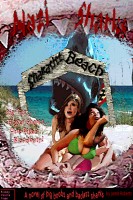Here's something original: a group of young adults find an excuse to drive into Middle of the Woods, Nowhere, where something bad happens and they start getting killed. Even more original is that half of the group is male and the other half female, guaranteeing sexual banter and activity. Thus is the plot to Primal, a film about an ancient cave painting and its surrounding grounds that seem to have the uncanny ability to transform animal life into ravenous monstrosities of a very high order. Dace, an anthropology student, survivalist, and, of course, part-time bodybuilder, leads his five friends to the undiscovered painting for the purposes of producing the greatest thesis ever, but finds, instead, sex and violence.
Since the title is 'Primal', we may as well begin with primality. The primal human is driven not so much by considered desires but by biological necessities: to survive and to reproduce. Survival involves hunting and defending himself and his own. Reproduction obviously involves a man spraying semen in a woman. So, primality involves sex and violence. What's most interesting about Primal is the dynamic it creates out of its characters' attitudes towards primal behaviours.
The obligatory car ride into the jungle economically acquaints us with these in three pairings: Dace is the sexual and rough alpha male; Mel is a flirtatious, sexual and domineering female. Chad is a bookish alpha-male-wannabe who obliges his girlfriend's (Mel's) sexual urges, but isn't always 'into it'; Kris is a girl-next-door whose greatest dream in life is to make babies. Warren is a joker who remains detached from sexual politics and interests except for comedic purposes; Anja is intelligent, independent, and more introspective--the Final Girl, in short. The first pairing is the most sexual and most capable of violence; the second stage is the ordinary and average; the third stage the more introspective and least capable of violence.
The journey from cultivated university life to the primitive jungle parallels an interior movement from refinement to primal behaviour that emphasizes the sex-and-power politics hidden beneath the veneer of civility. Chad's submissive character, for instance, fills him with resentment toward his girlfriend for her emasculating strength and Dace for his dominant personality, and toward both for their mutual flirtation. Mel insists on talking about her genitals and tries to force Anja to say 'cunt'; she also plays flirtatiously with every male.
The film's symbological structure emphasizes this movement. The film's activity is divided between a few locations that all have culturally-accepted phenomenological significances: the campfire, with its connotations of civilization, is the place where the group tries to fight back the onslaught of primality; the murky pond, a stock-image for the subconscious, is the place the infection derives from; the dark, stifling cave, in which the source of the infection resides, is a conceptual cognate of a womb, where the most primal of a being and/or species dwells.
Naturally it is Mel and Dace that are first affected by the forces at work in the film. Mel becomes a savage huntress, all fangs, stalking the prey of her former friends. Soon she finds a co-hunter and mate in Dace. This leaves the surviving members of the party to escape one way or another. The behaviour of each character is an expression of the tensions set up in the car trip that comprises the film's first act. Chad will face Dace, Anja will face Mel and, of course, the cave, and Kris will endure a poetic, if blackly comic, fate.
This is not to say the film's characterization is particularly strong. They are for the most part stock characters one finds in any commercial horror film. The bulk of characterization is put on Anja--as is the lot of the Final Girl--and what there is of it is pretty shallow: she is afraid of dark, enclosed places. Caves, for instance. The film's strength is in playing these stock characters against each other in a situation where their stock characteristics, viz. their attitudes toward sex and their position in the social hierarchy, really are salient points about them and about humanity. A sort of meaningful generality is drawn out of these stocks by virtue of the film's emphasis on dynamics of sex and power.
Where the film does faulter is not in its content, but in its form. When sitting at one's editing software, it's perhaps easy to imagine that highly-kinetic camera movements combined with fast cutting is going to lead to heightened intensity for the viewer. To a certain extent, it does. If the camera moves too fast and the cuts come too soon, however, the effect is lost. The cinematographer of this film has difficulty standing still during any intense scene and the editor can't hold an idea for a second. There are also a series of zoom-ins and zoom-outs that occur at these moments, whether added in-camera or during editing I don't know, that distracted from the action even further. The director, no doubt, desired to have the audience share in the confusion of the characters. But an audience can be trusted, with some subtle assistance, to empathize their way into feeling that confusion without unpleasant camera-work. For a film that otherwise uses conventional style, the subjective camerawork is neither necessary nor helpful.
Nevertheless, Primal does contain a fair number of suspenseful moments and is deftly able to sustain its mounting tension to the climactic moment. The director makes skilled use of his stock characters and claustrophobic situation to pull the audience toward a surprising and fascinating conclusion that, hopefully, will make you think of what I've said in this review: Primality is all about eating and screwing.
Help make this site more interesting through discussion:
Primal (2010) - 2.5/4
Author: Jared Roberts
Subscribe to:
Post Comments (Atom)

0 comments:
Post a Comment